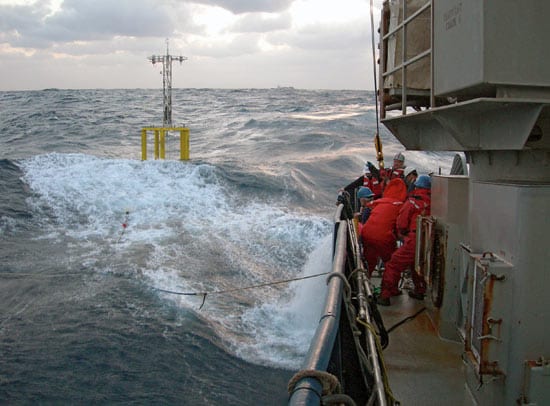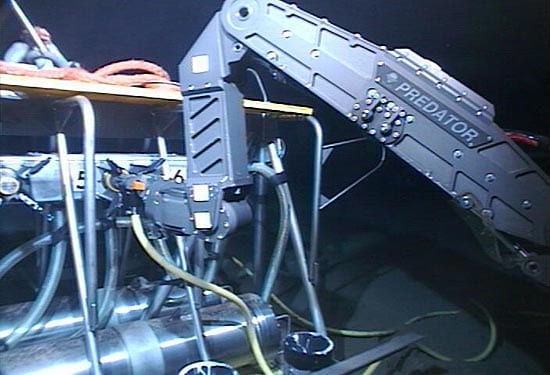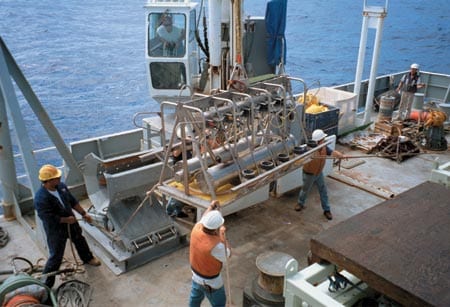Who Builds Them?
Several universities, institutions, government agencies, and researchers have built or are in the process of building ocean observatories, observing systems, and pieces of such infrastructure. Those programs are funded primarily by governments—particularly the National Science Foundation and the National Oceanic and Atmospheric Adminstration—though some of the costs are shared by states or provided by private donors and investors.
Major Observatory Projects and Programs
OOI - Ocean Observatories Initiative
The Ocean Sciences Division of the National Science Foundation has developed the six-year, $309 million Ocean Observatories Initiative (OOI) to help the research community build the infrastructure required to make sustained, long-term, and adaptive measurements of the fundamental processes at work in the oceans. The OOI is an outgrowth of many years of community-wide scientific planning efforts, both nationally and internationally, and builds upon recent technological advances, experience with existing observatories, and several successful pilot and testbed projects. NSF and the Bush Adminstration have proposed to start funding for OOI in the 2007 fiscal year.
» Read an NSF article about OOI
Oceans.US and IOOS - Integrated and Sustained Ocean Observation Systems
Oceans.US was created by the National Oceanographic Partnership Program to coordinate the development of an operational, integrated, and sustained ocean observing system. One of its principal roles is to provide guidance and coordination for IOOS, which is spearheaded by the National Oceanic and Atmospheric Administration and includes several federal agencies. IOOS is focused on environmental monitoring that can immediately serve national needs for: detecting and forecasting oceanic components of climate variability; mitigating natural hazards; facilitating safe and efficient marine operations; ensuring national security; ensuring public health; managing resources for sustainable use; and preserving and restoring healthy marine ecosystems.
» Visit the Oceans.US web site
GEOSS - Global Earth Observation System of Systems
In 2005, 61 countries agreed to a 10-year plan to revolutionize our understanding of the earth, oceans, and atmosphere and how they interact. GEOSS is envisioned as a large national and international cooperative effort to bring together existing and new hardware and software and to make the environmental data and information compatible.
» Visit website
NOPP - National Oceanographic Partnership Program
NOPP is a collaboration of fifteen federal agencies to provide leadership and coordination of national oceanographic research and education initiatives. NOPP facilitates interactions among federal agencies, academia, and industry; increases visibility for ocean issues on the national agenda; and coordinates efforts across the broad oceanographic community.
» Visit the NOPP website
Laboratories and Groups Developing Observatory Technology
COSMOS - WHOI Center for Ocean, Seafloor, and Marine Observing Systems
Woods Hole Oceanographic Institution established COSMOS to provide systems engineering, administrative, and management oversight for large observing system projects. Building on decades of experience in designing, constructing, deploying, and operating marine observing systems, COSMOS will coordinate diverse Woods Hole efforts to develop new observatory sensors and systems while fostering collaborations between research labs around the world. The center is particularly focused on the Ocean Research Interactive Observatories Network (ORION) and on developing and supporting coastal observatories and observing systems in the Northeastern United States.
LOOKING - Laboratory for the Ocean Observatory Knowledge INtegration Grid
LOOKING is a collaborative effort between the University of Washington, Woods Hole Oceanographic Institution, and the University of California-San Diego to identify, synthesize, and assemble existing and emerging technologies into cyberinfrastructure design. The goal is to create a fully autonomous sensor network capable of evolving and adapting to changes during the life cycle of an ocean observatory.
» Visit website
NEPTUNE Data Communications Project
Led by the Woods Hole Oceanographic Institution, this group is working to design and implement the undersea data communications network that will meet the communications requirements for the NEPTUNE observatory.
» Visit website
New Approaches for Coastal Observatories
The U.S. Geological Survey and Woods Hole Oceanographic Institution--in cooperation with the U.S. Coast Guard, the Massachusetts Water Resources Authority, and RD Instruments--are developing a low-cost system for retrieving oceanographic data from instruments in the coastal ocean.
» Visit website
Center for Earth Observations and Applications
Led by Scripps Institution of Oceanography, CEOA is working to coordinate and integrate research projects in the natural, physical, and social sciences, engineering, and information technology at several California-based institutions.
Ocean Observatories at Monterey Bay Aquarium Research Institute
Through projects such as MARS and the Monterey Ocean Observing System, MBARI is working to integrate and coordinate the simultaneous use of moorings, cabled observatories, and autonomous underwater vehicles while developing novel chemical and biological sensors and platforms for ocean observing.
» Visit website
See Also
Building the Hawaii-2 Observatory
In September 1998, a permanent deep ocean scientific research facility was installed on a retired AT&T submarine telephone cable that runs between Oahu, Hawaii, and the California coast.



